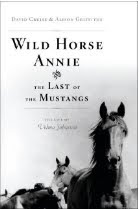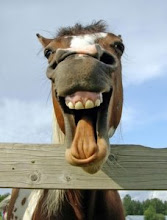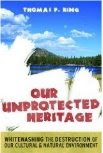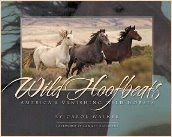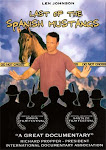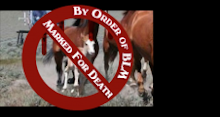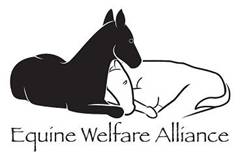With the slew of various agencies, big game organizations like the Safari Club and environmental organizations such as the recent addition of the National Wildlife Federation lining up with Letters of Support for the Bureau of Land Management's ill-conceived plan to remove wild horses from the Calico Complex in Northern Nevada for approximately two months during the dead of winter or cattleman Secretary Salazar's plan for the future of the American Mustang & Burro, Western Watershed Projects Biodiversity Director Katie Fite recently shared both her knowledge and views about the "elephant in the room" many of these organizations are failing to address.
Using the background and history of BLMs management of the Calico Complex as an example of what's at play behind the scenes, Katie lends her expertise to provide an indepth look at what "on-the-range-management" means to BLM, wildlife, wild horses and the American public.
Using the background and history of BLMs management of the Calico Complex as an example of what's at play behind the scenes, Katie lends her expertise to provide an indepth look at what "on-the-range-management" means to BLM, wildlife, wild horses and the American public.

Wild Horse Round Up: Black Rock Range West 2004
BLM File Photo- Courtesy of Katie Fite
HOW FORAGE, WATER, AND SPACE FOR ANIMALS ON
PUBLIC LANDS IS HANDED OVER TO RANCHERS,
AND THE PUBLIC LOSES OUT
Courtesy of Katie Fite
Reprinted with permission.
The Setting
The Safari Club and some Wilderness advocates lose out in BLM grazing decisions and lax management all the time. Perhaps it is easier for them to generate an “enemy” such as wild horses to blindly blame all ecological damage on rather than confront the truth and seek honesty of Ken Salazar’s Interior Department and the BLM in its management of wildlife habitats and public lands.
To illustrate what is really happening behind the scenes, I’ll use the Paiute Meadows Allotment as an example of how grass, water and space are taken away from wildlife and wild horses on public lands by BLM and then given to a large cattle ranch for its profits.
The Paiute Meadows allotment is 117,096 acres, with 72,433 acres designated as Wilderness. The land area of Paiute Meadows allotment includes all of the Black Rock East wild horse Herd Management Area (HMA), which is the eastern part of the big Calico Complex wild horse round up. It is also where the Calico round up began, in the snow and on private land so BLM could limit public access and scrutiny.
The Black Rock Range is a spectacular place. Picture a big rugged irregular very steep-sided plateau cut by canyons. Part of the top, and the east side down to the valley floor is the ”official” Black Rock East HMA. The other side is the Black Rock West HMA, one of the three HMAs in the contiguous Soldier Meadows allotment (Black Rock West, Warm Springs, part of Calico HMA). The Range lies by the northern Black Rock Playa. From its top, in Wilderness, tremendous views of the Jackson Mountain skyline unfold - as Gary Snyder writes in Mountains and Rivers without End, “the tooth of a far peak called King Lear”.
There is no fence on the top of mountain range to separate the two grazing allotments that border one another here, Paiute Meadows and Soldier Meadows. The BLM artificially drew the wild horse HMA lines on the boundary between two cattle empires. The boundary has very little to do with wild horses – and everything to do with cows. There is only an artificial line on the maps in the Winnemucca BLM office that actually separates the wild horses areas and animals move freely back and forth.
This serves as an example of how BLM contrives to artificially chop up landscapes to maximize cattle numbers at the expense of all other values. Once BLM draws an imaginary horse area separation line, then they can try to incrementally sneak in fencing over time - on the basis of their fabrication of separation between two HMAs. The BLM range folks have long lusted to build a fence on top of the mountain range between the cattle allotments.
A fence on top of the range would be a disaster not only for horses, but for sage-grouse and big game too. I see sage-grouse nearly every time I go hiking in this Wilderness. Fences are a big problem for sage-grouse as they collide with fences and die. This area is critical for sage-grouse nesting and brood rearing.
The only reason BLM hadn’t built a fence already is the horses, as there has been pushback from their own wild horse specialists. However, if more pliant wild horse specialists get put in place, which could well happen after this Calico Complex debacle, one has to fear the worst.
Cattle trespass has long been rampant on the top of the Black Rock Range in Colman Creek and other headwater areas. Ranchers have not controlled their cattle as they are required to do, and Winnemucca BLM has allowed this to continue year after year. I have complained often in the past but Winnemucca BLM has given me the impression that the public pointing out cattle trespass is at times more of a problem than the trespass itself.
I hiked into this Wilderness area again in September 2009, and recent cow manure was everywhere; across the top and higher elevations in both Paiute Meadows and Soldier Meadows. There was no scheduled cattle grazing in that area of Soldier Meadows in 2009, as it was theoretically being “rested” from cattle but I witnessed springs, seeps and long lengths of Colman Creek headwaters that were chock full of fresh cattle manure.
This uncontrolled and routine trespass BLM allows to occur here year after year, including in areas that are being “rested”, directly takes grass out of the mouths of wildlife and wild horses. Who knows how many “AUMs” get consumed annually out here by unauthorized cattle grazing?
Background: BLM Sets Carrying Capacity and Wild Horse Numbers (AML) in 1994-1995 Decision for Paiute Meadows and Soldier Meadows Grazing Allotments
In 1995, BLM authorized a livestock grazing, wildlife and wild horse “Final Multiple Use Decision (FMUD) for Paiute Meadows that set the basic wild horse numbers (AML) that remain to this day. BLM has refused to use new info to update the AML. BLM calculated what it calls a carrying capacity based largely on “forage”, but the carrying capacity for this whole area that was calculated back then was recognized as flawed. Everyone from the Nevada Department of Wildlife (NDOW) to Wild Horse Groups to the Sierra Club complained - but BLM just did what they wanted.
The BLM Winnemucca Field Office has long known that the carrying capacity for Paiute Meadows and Soldier Meadows is invalid. But BLM and/or ranchers seem to really like it because it lets them keep the cow numbers higher, bumps up the re-sale price of ranches, allows ranchers to get loans from banks based on a higher number of cattle and get more tax dollars as subsidies. Ranchers can get loans on public lands by using cattle AUMs as collateral, as well as Annual Operating Loans. They can also get “disaster” payments from tax dollars for drought based on head of cattle.
When reading these BLM Decisions, the Active or Authorized AUMs are what to focus on, as the Suspended AUMs are pie-in-the-sky “paper cows” and are often based on rancher claims with numbers drawn out of thin air in the distant past from adjudication processes that had no basis in reality. Ranchers today appear to use them largely to snooker hobby ranch buyers into paying more for a ranch with a public lands grazing permit than the permit is actually worth. To add fuel to the fire, BLM refuses to remove these AUMs from the books and thereby creates a constant tension with ranchers as they are always wanting to get “their” paper cows back as real cows out on the land.
Flawed 1994-1995 Decisions and methods used to determine carrying capacity in both Paiute Meadows and Soldier Meadows Allotments set the stage for carrying capacity conflicts right up to the present 2009 Calico Complex Round Up.
Bob Abbey, BLM Director in Nevada and the Paiute Meadows 2003 Final Multiple Use Decision (FMUD)
Beginning in 2001, BLM started conducting a combined Soldier Meadows and Paiute Meadows Grazing Evaluation process. New decisions came down at slightly different times. Paiute Meadows came out first. The Soldier Meadows rancher at the time wanted quite an audacious and controversial cow proposal, which he ultimately got with Bob Abbey as Nevada State Director. Then later, in 2008, BLM issued yet another Decision where the current Soldier Meadows operation got an even sweeter deal.
To return to Paiute Meadows, in 2003, BLM then issued an updated grazing document called a “FMUD” Final Multiple Use Decision because it included cattle, wildlife and horses. There has not been a new grazing decision for the Paiute Meadows Allotment since 2003.
Wild Horses
Here’s what the Paiute Meadows FMUD did: It carried forward the old 1994-95 Black Rock Range East Wild Horse AML number. BLM stated “we are re-affirming our previous management action ... that established the AML for the Black Rock Range East HMA at 93 head [of horses]”. The horse numbers were set between a range of 56 horses (low) and 93 horses (high). The amount of AUMs (Animal Unit Months) BLM states is appropriate for wild horse use was set between 672 AUMs for all year (for the 53 horses), and 1,116 AUMs for all year (for the cap of 93 horses). So 93 wild horses is the maximum population BLM paperwork allows.
During the 2003 Paiute Meadows evaluation process, Winnemucca BLM stated: ”Based on monitoring data collected during the re-evaluation period, there have not been any significant problems associated with the wild horse use of the range”!!!
Now, based on other BLM documents that show wild horse populations during this time period (1994-2003), it is clear that horses were rarely, if ever at AML; they were always above AML! So what Winnemucca BLM really said here is, while wild horses were actually greatly over AML the whole time, they were not causing significant problems to the range!
In fact, when it issued its 1994 Decision in Soldier Meadows paralleling the Paiute Meadows process where it referred to the “Black Rock Range” horses, BLM stated: “Once AML is reached – which should take two gather cycles - in about six years, wild horse and burro population will be maintained within the following ranges in order to ensure that the carrying capacity is not exceeded. These ranges are based on gathering horses every three years. If gathering schedules change, these ranges may change".
Wildlife
The 2003 Paiute Meadows Decision also carried forward the old 1994-95 wildlife allocations. These were established as a combined total of 2,325 AUMs for mule deer, pronghorn antelope, and bighorn sheep. This too was derived from the flawed BLM 1994-95 carrying capacity computations. In 2003, BLM stated that the wildlife weren’t causing any problems, so the wildlife got the same theoretical amount of forage as in 1995.
The only wildlife that gets anything allocated to it by BLM has antlers.
Cattle
While BLM rubber stamped the same forage allocations for wild horses and wildlife in the 2003 Paiute Meadows FMUD, what was NOT the same was the cattle AUMs; those were increased from 3550 active AUMs to 4298 Active AUMs. BLM approved of the increase in cattle AUMs to allow for an additional “300 head within the South Paiute low elevation area in spring and winter”.
Astute readers of the 2003 Paiute Meadows Decision will find a math error in the text, where BLM appears to have been trying to minimize public perception of how much the cow increase really was. And a confusing chart that shows not all the added cattle AUMs in this new Decision were actually where BLM claimed they were. But since this whole forage and numbers game is largely flimflam anyway – EXCEPT when BLM wants to round up horses – what’s a few percentage points, or why bother actually keeping the cow increase all in the area where you claim it is?
The 2003 Paiute Meadows Decision also revealed that BLM had already been sneaking those 300 head of cattle in on a year-to-year basis by issuing something called a “TNR” permit (Temporary Non-Renewable grazing permit). BLM had been annually issuing these extra “temporary“ permits for 300 head of cows for several months in the winter in this low elevation area since 1998! Never mind how that conflicted with the “allocation” for wildlife or wild horses.
Then BLM justified this permanent increase in cattle AUMs by saying this area is outside their own artificially created wild horse HMA boundaries. Even if those 300 head of cattle are grazing outside the wild horse HMA boundary, which is in the east and south here, they are still in a spot where they will conflict with wildlife.
Thier extra cattle are reducing the available forage, water and space wildlife need, and if the ranchers check on the cows, they also add to further disturbances of wildlife in the area especially in winter. But BLM sure doesn’t seem to care much any more about disturbing wintering wildlife as is evident by the Calico Complex round up being conducted in the dead of winter.
It was Bob Abbey, then Nevada BLM Director who was overseeing the Winnemucca Field Office when this 2003 FMUD took grass, food, water, cover and space away from wildlife in the winter and gave it to the cattle industry. Abbey was very aware of what was transpiring in both Paiute Meadows and Soldier Meadows , which had long been areas of controversy.
Bob Abbey is now serving as Director of the BLM under Interior Secretary and rancher Ken Salazar. Abbey and the current Winnemucca BLM Manager, Gene Seidlitz, were both involved in the Paiute Meadows and Soldier Meadows processes. I participated in a Range Tour with Director Abbey and the ranchers in both allotments at the time in 2003.
However, wildlife wasn’t the only loser in this deal as BLM also took forage away from the wild horses too and justified this by other artificial lines they drew on the east side of the HMA, mapping the area part way up the slope of the range.
As a final note, during the prolonged 2003 and 2004 Paiute Meadows and Soldier Meadows allotment processes, Nevada Department of Wildlife as well as U.S. Fish and Wildlife Service are on record as telling Winnemucca BLM that information that was essential to base ANY new decision on was lacking. Yet BLM ignored USFWS and NDOW and took forage, water and space away from wildlife and gave it to a big rancher instead.
Calico Wild Horse Capture EA - 2009
So in the early winter of 2009, BLM issues the Calico Wild Horse EA with its justifications for the dead of winter round up. Suddenly, all wildlife scientific literature to the contrary, BLM finds its just fine to disturb wildlife, including sage-grouse, over two solid months on their winter range on over a million acres of public lands.
BLM continues to claim drought as an issue, despite this region having experienced an extraordinarily moist spring and summer, and lush grass growth in 2009. They also make much ado about how winter range is so limited, horses must be rounded up right now.
BLM also claims they have been suddenly struck by a lightning bolt of new information regarding wild horses moving all over the place and uses this as justification to cast its horse capture net very wide over many HMAs, including into areas outside their artificial boundaries as well as into the very area that BLM claimed in 2003 “was outside the HMA”.
But there are documents in BLMs files that show they have known this whole area was a complex, and horses were moving outside their artificial lines - all along! The wider the net is cast, the more horses can be cleared out of the way for projects such as the upcoming Ruby pipeline that is barreling down on the north of this area.
As BLM spreads as broad a net as possible across the region to capture and remove horses including those outside the hokey HMA boundaries and specific allotment boundaries, they kept making noise about how wild horses outnumber cows in the area. Yet, it appears BLM has not factored in the cows that graze in the allotments surrounding the Calico Complex where they extended their capture net, which includes areas they have known wild horses have been present in all along.
If one were to compare BLMs capture area maps from the Calico Complex EA against maps from the 2003 Paiute Meadows EA, it can be seen that BLM cast its capture net into the very site where BLM justified increasing cow numbers in winter in 2003 because it was “outside” the hokey HMA lines.
When BLM was authorizing increases for cow numbers in Paiute Meadows in 2003, BLM said the area was outside the HMA, so increasing cows made no difference to wild horses. But the truth is, those wild horses from the South Paiute Meadows low elevation area very, very likely did rely on that same winter range that BLM authorized increased grazing on in 2003 merely for the financial benefit of the large rancher.
Through the Calico EA, BLM has then gone on to make claims about the great lack of winter habitat for wild horses, wildlife and everything else in the area. But by BLM allowing dead of winter grazing at this lower elevation during critical winter months, it has increased the stresses on all animals in the neighborhood and ecosystems.
So this leads to the question, why is Ken Salazar’s Interior continuing to mislead the public about wild horses, the relative impacts of cattle and horses and continued harmful cattle actions in the Calico Complex? This only serves to fuel controversy and destroy any efforts at “balance” on the public lands.
If environmental groups and organizations like the Safari Club want to jump into the middle of something, perhaps they should consider stopping the high jacking of public resources (food, water, and space) for private cattle ranchers and corporate profits as grazing on public lands adversely affects public lands and wildlife habitat that belong to all Americans, not just a few.
And the neighboring Soldier Meadows is where the imbalance and forage theft gets really twisted …
The Safari Club and some Wilderness advocates lose out in BLM grazing decisions and lax management all the time. Perhaps it is easier for them to generate an “enemy” such as wild horses to blindly blame all ecological damage on rather than confront the truth and seek honesty of Ken Salazar’s Interior Department and the BLM in its management of wildlife habitats and public lands.
To illustrate what is really happening behind the scenes, I’ll use the Paiute Meadows Allotment as an example of how grass, water and space are taken away from wildlife and wild horses on public lands by BLM and then given to a large cattle ranch for its profits.
The Paiute Meadows allotment is 117,096 acres, with 72,433 acres designated as Wilderness. The land area of Paiute Meadows allotment includes all of the Black Rock East wild horse Herd Management Area (HMA), which is the eastern part of the big Calico Complex wild horse round up. It is also where the Calico round up began, in the snow and on private land so BLM could limit public access and scrutiny.
The Black Rock Range is a spectacular place. Picture a big rugged irregular very steep-sided plateau cut by canyons. Part of the top, and the east side down to the valley floor is the ”official” Black Rock East HMA. The other side is the Black Rock West HMA, one of the three HMAs in the contiguous Soldier Meadows allotment (Black Rock West, Warm Springs, part of Calico HMA). The Range lies by the northern Black Rock Playa. From its top, in Wilderness, tremendous views of the Jackson Mountain skyline unfold - as Gary Snyder writes in Mountains and Rivers without End, “the tooth of a far peak called King Lear”.
There is no fence on the top of mountain range to separate the two grazing allotments that border one another here, Paiute Meadows and Soldier Meadows. The BLM artificially drew the wild horse HMA lines on the boundary between two cattle empires. The boundary has very little to do with wild horses – and everything to do with cows. There is only an artificial line on the maps in the Winnemucca BLM office that actually separates the wild horses areas and animals move freely back and forth.
This serves as an example of how BLM contrives to artificially chop up landscapes to maximize cattle numbers at the expense of all other values. Once BLM draws an imaginary horse area separation line, then they can try to incrementally sneak in fencing over time - on the basis of their fabrication of separation between two HMAs. The BLM range folks have long lusted to build a fence on top of the mountain range between the cattle allotments.
A fence on top of the range would be a disaster not only for horses, but for sage-grouse and big game too. I see sage-grouse nearly every time I go hiking in this Wilderness. Fences are a big problem for sage-grouse as they collide with fences and die. This area is critical for sage-grouse nesting and brood rearing.
The only reason BLM hadn’t built a fence already is the horses, as there has been pushback from their own wild horse specialists. However, if more pliant wild horse specialists get put in place, which could well happen after this Calico Complex debacle, one has to fear the worst.
Cattle trespass has long been rampant on the top of the Black Rock Range in Colman Creek and other headwater areas. Ranchers have not controlled their cattle as they are required to do, and Winnemucca BLM has allowed this to continue year after year. I have complained often in the past but Winnemucca BLM has given me the impression that the public pointing out cattle trespass is at times more of a problem than the trespass itself.
I hiked into this Wilderness area again in September 2009, and recent cow manure was everywhere; across the top and higher elevations in both Paiute Meadows and Soldier Meadows. There was no scheduled cattle grazing in that area of Soldier Meadows in 2009, as it was theoretically being “rested” from cattle but I witnessed springs, seeps and long lengths of Colman Creek headwaters that were chock full of fresh cattle manure.
This uncontrolled and routine trespass BLM allows to occur here year after year, including in areas that are being “rested”, directly takes grass out of the mouths of wildlife and wild horses. Who knows how many “AUMs” get consumed annually out here by unauthorized cattle grazing?
Background: BLM Sets Carrying Capacity and Wild Horse Numbers (AML) in 1994-1995 Decision for Paiute Meadows and Soldier Meadows Grazing Allotments
In 1995, BLM authorized a livestock grazing, wildlife and wild horse “Final Multiple Use Decision (FMUD) for Paiute Meadows that set the basic wild horse numbers (AML) that remain to this day. BLM has refused to use new info to update the AML. BLM calculated what it calls a carrying capacity based largely on “forage”, but the carrying capacity for this whole area that was calculated back then was recognized as flawed. Everyone from the Nevada Department of Wildlife (NDOW) to Wild Horse Groups to the Sierra Club complained - but BLM just did what they wanted.
The BLM Winnemucca Field Office has long known that the carrying capacity for Paiute Meadows and Soldier Meadows is invalid. But BLM and/or ranchers seem to really like it because it lets them keep the cow numbers higher, bumps up the re-sale price of ranches, allows ranchers to get loans from banks based on a higher number of cattle and get more tax dollars as subsidies. Ranchers can get loans on public lands by using cattle AUMs as collateral, as well as Annual Operating Loans. They can also get “disaster” payments from tax dollars for drought based on head of cattle.
When reading these BLM Decisions, the Active or Authorized AUMs are what to focus on, as the Suspended AUMs are pie-in-the-sky “paper cows” and are often based on rancher claims with numbers drawn out of thin air in the distant past from adjudication processes that had no basis in reality. Ranchers today appear to use them largely to snooker hobby ranch buyers into paying more for a ranch with a public lands grazing permit than the permit is actually worth. To add fuel to the fire, BLM refuses to remove these AUMs from the books and thereby creates a constant tension with ranchers as they are always wanting to get “their” paper cows back as real cows out on the land.
Flawed 1994-1995 Decisions and methods used to determine carrying capacity in both Paiute Meadows and Soldier Meadows Allotments set the stage for carrying capacity conflicts right up to the present 2009 Calico Complex Round Up.
Bob Abbey, BLM Director in Nevada and the Paiute Meadows 2003 Final Multiple Use Decision (FMUD)
Beginning in 2001, BLM started conducting a combined Soldier Meadows and Paiute Meadows Grazing Evaluation process. New decisions came down at slightly different times. Paiute Meadows came out first. The Soldier Meadows rancher at the time wanted quite an audacious and controversial cow proposal, which he ultimately got with Bob Abbey as Nevada State Director. Then later, in 2008, BLM issued yet another Decision where the current Soldier Meadows operation got an even sweeter deal.
To return to Paiute Meadows, in 2003, BLM then issued an updated grazing document called a “FMUD” Final Multiple Use Decision because it included cattle, wildlife and horses. There has not been a new grazing decision for the Paiute Meadows Allotment since 2003.
Wild Horses
Here’s what the Paiute Meadows FMUD did: It carried forward the old 1994-95 Black Rock Range East Wild Horse AML number. BLM stated “we are re-affirming our previous management action ... that established the AML for the Black Rock Range East HMA at 93 head [of horses]”. The horse numbers were set between a range of 56 horses (low) and 93 horses (high). The amount of AUMs (Animal Unit Months) BLM states is appropriate for wild horse use was set between 672 AUMs for all year (for the 53 horses), and 1,116 AUMs for all year (for the cap of 93 horses). So 93 wild horses is the maximum population BLM paperwork allows.
During the 2003 Paiute Meadows evaluation process, Winnemucca BLM stated: ”Based on monitoring data collected during the re-evaluation period, there have not been any significant problems associated with the wild horse use of the range”!!!
Now, based on other BLM documents that show wild horse populations during this time period (1994-2003), it is clear that horses were rarely, if ever at AML; they were always above AML! So what Winnemucca BLM really said here is, while wild horses were actually greatly over AML the whole time, they were not causing significant problems to the range!
In fact, when it issued its 1994 Decision in Soldier Meadows paralleling the Paiute Meadows process where it referred to the “Black Rock Range” horses, BLM stated: “Once AML is reached – which should take two gather cycles - in about six years, wild horse and burro population will be maintained within the following ranges in order to ensure that the carrying capacity is not exceeded. These ranges are based on gathering horses every three years. If gathering schedules change, these ranges may change".
Wildlife
The 2003 Paiute Meadows Decision also carried forward the old 1994-95 wildlife allocations. These were established as a combined total of 2,325 AUMs for mule deer, pronghorn antelope, and bighorn sheep. This too was derived from the flawed BLM 1994-95 carrying capacity computations. In 2003, BLM stated that the wildlife weren’t causing any problems, so the wildlife got the same theoretical amount of forage as in 1995.
The only wildlife that gets anything allocated to it by BLM has antlers.
Cattle
While BLM rubber stamped the same forage allocations for wild horses and wildlife in the 2003 Paiute Meadows FMUD, what was NOT the same was the cattle AUMs; those were increased from 3550 active AUMs to 4298 Active AUMs. BLM approved of the increase in cattle AUMs to allow for an additional “300 head within the South Paiute low elevation area in spring and winter”.
Astute readers of the 2003 Paiute Meadows Decision will find a math error in the text, where BLM appears to have been trying to minimize public perception of how much the cow increase really was. And a confusing chart that shows not all the added cattle AUMs in this new Decision were actually where BLM claimed they were. But since this whole forage and numbers game is largely flimflam anyway – EXCEPT when BLM wants to round up horses – what’s a few percentage points, or why bother actually keeping the cow increase all in the area where you claim it is?
The 2003 Paiute Meadows Decision also revealed that BLM had already been sneaking those 300 head of cattle in on a year-to-year basis by issuing something called a “TNR” permit (Temporary Non-Renewable grazing permit). BLM had been annually issuing these extra “temporary“ permits for 300 head of cows for several months in the winter in this low elevation area since 1998! Never mind how that conflicted with the “allocation” for wildlife or wild horses.
Then BLM justified this permanent increase in cattle AUMs by saying this area is outside their own artificially created wild horse HMA boundaries. Even if those 300 head of cattle are grazing outside the wild horse HMA boundary, which is in the east and south here, they are still in a spot where they will conflict with wildlife.
Thier extra cattle are reducing the available forage, water and space wildlife need, and if the ranchers check on the cows, they also add to further disturbances of wildlife in the area especially in winter. But BLM sure doesn’t seem to care much any more about disturbing wintering wildlife as is evident by the Calico Complex round up being conducted in the dead of winter.
It was Bob Abbey, then Nevada BLM Director who was overseeing the Winnemucca Field Office when this 2003 FMUD took grass, food, water, cover and space away from wildlife in the winter and gave it to the cattle industry. Abbey was very aware of what was transpiring in both Paiute Meadows and Soldier Meadows , which had long been areas of controversy.
Bob Abbey is now serving as Director of the BLM under Interior Secretary and rancher Ken Salazar. Abbey and the current Winnemucca BLM Manager, Gene Seidlitz, were both involved in the Paiute Meadows and Soldier Meadows processes. I participated in a Range Tour with Director Abbey and the ranchers in both allotments at the time in 2003.
However, wildlife wasn’t the only loser in this deal as BLM also took forage away from the wild horses too and justified this by other artificial lines they drew on the east side of the HMA, mapping the area part way up the slope of the range.
As a final note, during the prolonged 2003 and 2004 Paiute Meadows and Soldier Meadows allotment processes, Nevada Department of Wildlife as well as U.S. Fish and Wildlife Service are on record as telling Winnemucca BLM that information that was essential to base ANY new decision on was lacking. Yet BLM ignored USFWS and NDOW and took forage, water and space away from wildlife and gave it to a big rancher instead.
Calico Wild Horse Capture EA - 2009
So in the early winter of 2009, BLM issues the Calico Wild Horse EA with its justifications for the dead of winter round up. Suddenly, all wildlife scientific literature to the contrary, BLM finds its just fine to disturb wildlife, including sage-grouse, over two solid months on their winter range on over a million acres of public lands.
BLM continues to claim drought as an issue, despite this region having experienced an extraordinarily moist spring and summer, and lush grass growth in 2009. They also make much ado about how winter range is so limited, horses must be rounded up right now.
BLM also claims they have been suddenly struck by a lightning bolt of new information regarding wild horses moving all over the place and uses this as justification to cast its horse capture net very wide over many HMAs, including into areas outside their artificial boundaries as well as into the very area that BLM claimed in 2003 “was outside the HMA”.
But there are documents in BLMs files that show they have known this whole area was a complex, and horses were moving outside their artificial lines - all along! The wider the net is cast, the more horses can be cleared out of the way for projects such as the upcoming Ruby pipeline that is barreling down on the north of this area.
As BLM spreads as broad a net as possible across the region to capture and remove horses including those outside the hokey HMA boundaries and specific allotment boundaries, they kept making noise about how wild horses outnumber cows in the area. Yet, it appears BLM has not factored in the cows that graze in the allotments surrounding the Calico Complex where they extended their capture net, which includes areas they have known wild horses have been present in all along.
If one were to compare BLMs capture area maps from the Calico Complex EA against maps from the 2003 Paiute Meadows EA, it can be seen that BLM cast its capture net into the very site where BLM justified increasing cow numbers in winter in 2003 because it was “outside” the hokey HMA lines.
When BLM was authorizing increases for cow numbers in Paiute Meadows in 2003, BLM said the area was outside the HMA, so increasing cows made no difference to wild horses. But the truth is, those wild horses from the South Paiute Meadows low elevation area very, very likely did rely on that same winter range that BLM authorized increased grazing on in 2003 merely for the financial benefit of the large rancher.
Through the Calico EA, BLM has then gone on to make claims about the great lack of winter habitat for wild horses, wildlife and everything else in the area. But by BLM allowing dead of winter grazing at this lower elevation during critical winter months, it has increased the stresses on all animals in the neighborhood and ecosystems.
So this leads to the question, why is Ken Salazar’s Interior continuing to mislead the public about wild horses, the relative impacts of cattle and horses and continued harmful cattle actions in the Calico Complex? This only serves to fuel controversy and destroy any efforts at “balance” on the public lands.
If environmental groups and organizations like the Safari Club want to jump into the middle of something, perhaps they should consider stopping the high jacking of public resources (food, water, and space) for private cattle ranchers and corporate profits as grazing on public lands adversely affects public lands and wildlife habitat that belong to all Americans, not just a few.
And the neighboring Soldier Meadows is where the imbalance and forage theft gets really twisted …







